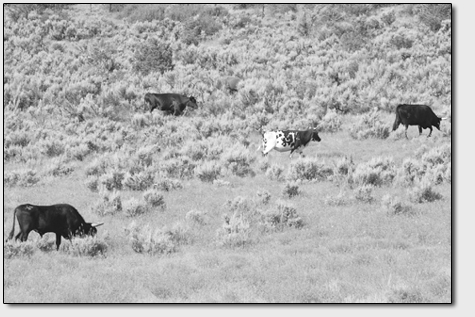|
|
||
|
Public land grazing rules relaxed Bush administration move outrages conservationists SideStory: Insiders allege 'whitewash:' Scientists claim BLM obscured findings
by Will Sands Many local ranchers are currently honoring the annual cycle and sending their cattle out to summer pasture on Bureau of Land Management lands. Many also are hailing the recent release of new guidelines that will ease their future use of those public lands. In contrast, conservation groups are outraged by the new BLM regulations, saying that the public is being squeezed out of public lands. Grazing has been an accepted use of public lands since 1906. Currently, 114 area ranchers pay to graze more than 30,000 cows and sheep on area BLM land. The base fee for these permitees is $1.35 per head of livestock per month, and the situation for these tenants of public land is only going to get easier in coming months. “The changes will make it so we can work better with our permitees and improve the health and productivity of public lands,” said Tom Gorey, BLM spokesman. “We’ll be able to streamline the process and make our management of rangeland more effective.” The new grazing regulations are expected to take effect in coming months and are aimed at improving the situation for public lands ranchers. They endeavor to improve the agency’s working relationships with BLM grazing permitees, protect the quality of rangelands and enhance administrative efficiency. “We’ve acknowledged that grazing is a legally recognized use of public lands,” Gorey said. “We regard it as important to our multiple-use mission. We’re seeking to improve our management of that legal use and thereby improve the health and productivity of our public rangeland.” Cattlemen appear to be widely in favor of the changes, particularly the streamlining of the administrative process. Terry Fankhauser, executive vice-president of the Colorado Cattlemen’s Association, noted that the association worked closely with the BLM on the development of the new rules. “For the most part, they are a significant improvement,” he said. “The process needed to be examined and streamlined to be more efficient for personnel as well as the users of the land. We’ll be spending agency time a lot more effectively under the new rules.” Jeff Eisenberg, of the National Cattlemen’s Beef Association, concurred, saying that the move would help ensure the future viability of cattle ranching. “We are grateful to the Bush administration for taking a step toward a regulatory system that will better enhance the business climate for our nation’s public lands ranchers,” he said. “The BLM is taking steps toward strengthening the future of our industry.” While the agency and the permitees are applauding the new rules, numerous conservation groups are “disgusted” with them. The Durango-based Great Old Broads for Wilderness is among them. Great Old Broads has long objected to public lands grazing as an uneconomical and destructive use of a public resource. Grazing is the top cause of threatened and endangered species and a leading cause of desertification in the West, according to the group. “Speaking personally, very few grazing allotments that I’ve looked at fit the old rangeland health standards that the BLM has published,” said Ronni Egan, executive director of Great Old Broads. “Plus, many of those allotments in the West have come up for renewal. For lack of money and staff, they’re just being rubber-stamp renewed.” Egan argued that the picture has gone from bad to worse under the new regulations. The same streamlining, being praised by the Colorado Cattlemen’s Association and BLM, amounts to a categorical exclusion of public input, she said. “The Bush administration has essentially thrown out the opinion and input of everyone who is not a grazing permitee,” Egan said. “That means the public has no voice on wildlife, watersheds, erosion or archeological impacts. Essentially, we’ve been cut out of the process.” The rule change appears to be more of the same from the Bush administration, according to Egan. “It’s just another case of lack of transparency on the part of the administration,” she said. “We don’t know how our public lands are being managed.” Santa Fe-based Forest Guardians also has sharp criticism for the new grazing rules. The group noted that the rules mark a management shift from wildlife, water and environment to working relationships with ranchers. Like Great Old Broads, Forest Guardians said that the rules will hit the public hardest. “The Bush administration is making it clear that they want to take the public out of public lands,” said Billy Stern, of Forest Guardians. Stern added that claims of benefits to the health of rangeland are little more than propaganda. “Only one of more than a dozen changes to the regulations has any potential benefit to streams and wildlife, while the rest move forward the administration’s agenda of privatizing public lands and limiting public involvement,” he said. Greta Anders, of the Center for Biological Diversity, also in Santa Fe, shared concerns about putting public lands under private control. “We are disgusted but not surprised by this administration’s consistent concern for private economic interests at the expense of public awareness and involvement,” she said. However, outside a legal framework, neither the groups nor citizens have many options at this point. The Bureau of Land Management will publish the final draft of the regulations in July, and they are expected to take effect in August. •
|
In this week's issue...
- May 15, 2025
- End of the trail
Despite tariff pause, Colorado bike company can’t hang on through supply chain chaos
- May 8, 2025
- Shared pain
Dismal trend highlights need to cut usage in Upper Basin, too
- April 24, 2025
- A tale of two bills
Nuclear gets all the hype, but optimizing infrastructure will have bigger impact


